
Barnstaple is a river-port town and civil parish in the North Devon district of Devon, England. The town lies at the River Taw's lowest crossing point before the Bristol Channel. From the 14th century, it was licensed to export wool from which it earned great wealth. Later it imported Irish wool, but its harbour silted up and other trades developed such as shipbuilding, foundries and sawmills. A Victorian market building survives, with a high glass and timber roof on iron columns.

Pilton is a suburb of the town of Barnstaple, it is located about quarter of a mile north of the town centre, in the civil parish of Barnstaple, in the North Devon district, in the county of Devon, England. It was formerly a separate village. The civil parish of Pilton West covers the more rural parts of the ancient parish of Pilton that have not been incorporated into the town of Barnstaple. In 2009, the Pilton (Barnstaple) ward had a population of 4,239 living in some 1,959 dwellings. It has its own infants and junior school, houses one of Barnstaple's larger secondary schools, and one of Barnstaple's SEN specialist schools. North Devon Hospital is also within West Pilton parish. It has a Church Hall, two public houses, two hotels, and residential homes. It has residential estates of both private and public housing including flats. It also has a historic Church that dates back to at least the 11th Century.
Juhel de Totnes, Latinised to Judhellus filius Aluredi, "Juhel son of Alured") was a soldier and supporter of William the Conqueror (1066–1087). He was the first feudal baron of Totnes and feudal baron of Barnstaple, both in Devon.

George Peard (1594–1645) of Barnstaple in Devon, England, was a politician who sat in the House of Commons of England from 1640 to 1645. He supported the Parliamentarians in the English Civil War.
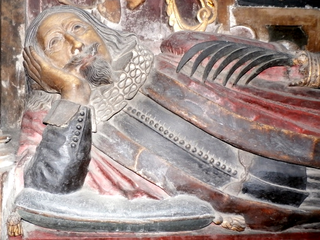
Richard Ferris was a wealthy merchant from Barnstaple in Devon, England who served as a Member of Parliament for Barnstaple in 1640 and served twice as Mayor of Barnstaple in 1632 and 1646. He founded the Barnstaple Grammar School, otherwise known as the "Blue School".

From AD 1066, the feudal barony of Barnstaple was a large feudal barony with its caput at the town of Barnstaple in north Devon, England. It was one of eight feudal baronies in Devonshire which existed in the Middle Ages. In 1236 it comprised 56 knight's fees or individual member manors. The feudal service owed for half the barony in 1274 was the provision to the royal army of two knights or four sergeants for forty days per annum, later commuted to scutage.
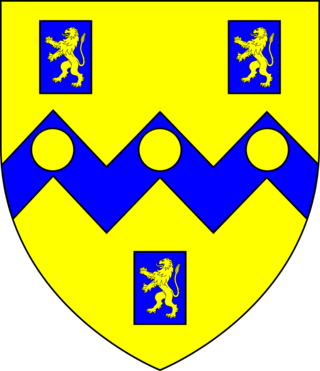
George Rolle of Stevenstone in the parish of St Giles in the Wood near Great Torrington in Devon, was the founder of the wealthy, influential and widespread Rolle family of Devon, who by 1842 had become the largest landowners in Devon with about 55,000 acres according to the Return of Owners of Land, 1873 in the person of Hon. Mark Rolle, the adoptive heir of John Rolle, 1st Baron Rolle. He was a Dorset-born London lawyer who in 1507 became Keeper of the Records of the Court of Common Pleas and was elected as a Member of Parliament for Barnstaple in 1542 and 1545. He became the steward of Dunkeswell Abbey in Devon, and following the Dissolution of the Monasteries he purchased much ex-monastic land in Devon. Not only was he the founder of his own great Devonshire landowning dynasty but he was also an ancestor of others almost as great, including the Acland baronets of Killerton, the Wrey Baronets of Tawstock and the Trefusis family of Trefusis in Cornwall now of Heanton Satchville, Huish, later Baron Clinton, heirs both of Rolle of Heanton Satchville, Petrockstowe and of Rolle of Stevenstone.

The historic manor of Raleigh, near Barnstaple and in the parish of Pilton, North Devon, England, was the first recorded home in the 14th century of the influential Chichester family of Devon. It was recorded in Domesday Book of 1086 together with three other manors that lay within the later-created parish of Pilton. The manor lies above the River Yeo on the southern slope of the hill on top of which stand the ruins of the Anglo-Saxon hillfort called Roborough Castle. Part of the historic manor of Raleigh is now the site of the North Devon District Hospital.

The landed gentry and nobility of Devonshire, like the rest of the English and European gentry, bore heraldic arms from the start of the age of heraldry circa 1200–1215. The fashion for the display of heraldry ceased about the end of the Victorian era (1901) by which time most of the ancient arms-bearing families of Devonshire had died out, moved away or parted with their landed estates.
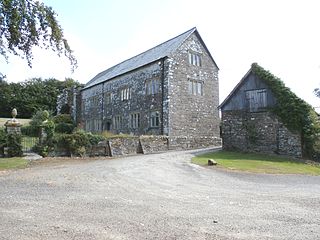
Bremridge is a historic estate within the former hundred of South Molton in Devon, England. It is now within the parish of Filleigh but was formerly in that of South Molton. It is situated 8 miles north-west of South Molton. Since the construction of the nearby A361 North Devon Link Road direct access has been cut off from Bremridge to Filleigh and South Molton. The surviving wing of the mansion house built in 1654 is a Grade II* listed building. Bremridge Wood is the site of an Iron Age enclosure or hill fort, the earthwork of which is situated on a hillside forming a promontory above the River Bray. In Bremridge Wood survives a disused tunnel of the former Great Western Railway line between South Molton and Barnstaple, much of the course of which has been used for the A361. The tunnel is 319 yards long and was identified as "Bremridge Tunnel" in the 1889 Ordnance Survey map but as "Castle Hill Tunnel" in subsequent editions.

Pilton House in the parish of Pilton, near Barnstaple, North Devon, Ex31, is an historic grade II listed Georgian mansion house built in 1746 by Robert Incledon (1676-1758), twice Mayor of Barnstaple, who was from nearby Braunton. It is situated almost in the centre of the ancient town of Pilton, but had formerly extensive grounds covering at least 20 acres, which extended down "Pilton Lawn", now built over, to the River Yeo. It later served as the residence for various Members of Parliament for Barnstaple, for which it was well suited being only a 10-minute walk from the centre of that town, yet in a secluded situation with extensive grounds, and sufficiently large and grand for entertaining borough officials and electors.

Robert Incledon (1676–1758) of Pilton House, Pilton, near Barnstaple in North Devon, was a lawyer of New Inn, London, a Clerk of the Peace for Devon, Deputy Recorder of Barnstaple and was twice Mayor of Barnstaple, in 1712 and 1721. In 1713 as mayor he supervised the building of the Mercantile Exchange on Barnstaple Quay, as recorded on the building by a contemporary brass plaque and sculpture of his armorials. He built Pilton House in 1746.
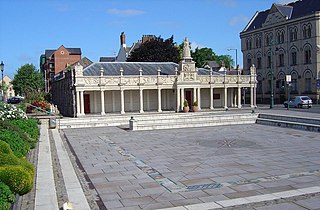
Queen Anne's Walk is a grade I listed building in the town of Barnstaple, North Devon, completed in 1713 as a meeting place for the town's merchants. It is believed to have been designed by the architect William Talman, on the basis of its similarity to his work at the Hall in Drayton, Northamptonshire. It was promoted and financed by the thirteen members of the Corporation of Barnstaple whose armorials are sculpted on and above the parapet, and the work was overseen by Robert Incledon (1676–1758), Mayor of Barnstaple in 1712–13. It has been owned for many decades by North Devon District Council, which currently (2014) leases it to Barnstaple Town Council, and now trades as The Cafe on the Strand.

St Peter's Church is the parish church of the town of Barnstaple in North Devon, England. Parts of the church date to the 13th-century with much restoration during the Victorian era by George Gilbert Scott and later by his son John Oldrid Scott which changed the atmosphere of the building, although many fine wall monuments and tablets remain. The church comes under the Diocese of Exeter.

Sir Nicholas II Hooper (1654-1731) of Fullabrook, Braunton and Raleigh, Pilton in Devon, was a lawyer who served as Tory Member of Parliament for Barnstaple 1695-1715.

Hawkridge in the parish of Chittlehampton in North Devon, England, is an historic estate, anciently the seat of a junior branch of the Acland family which originated at nearby Acland, in the parish of Landkey and later achieved great wealth and prominence as the Acland Baronets of Killerton, near Exeter. The former mansion house is today a farmhouse known as Hawkridge Barton, a grade II* listed building. The Devon historian Hoskins (1959) stated of Hawkridge: "Externally there is nothing remarkable except a decaying avenue of ancient walnuts, so often the first indication of a 16th or 17th century mansion". The interior contains a fine plaster heraldic overmantel showing the arms of Acland impaling Tremayne, representing the 1615 marriage of Baldwin Acland (1593–1659) of Hawkridge and Elizabeth Tremayne.

The recorder of Barnstaple was a recorder, a form of senior judicial officer, usually an experienced barrister, within the jurisdiction of the Borough of Barnstaple in Devon. He was usually a member of the local North Devonshire gentry. The position of recorder of any borough carried a great deal of prestige and power of patronage. The recorder of a borough was often entrusted by the mayor and corporation to nominate its Members of Parliament, as was the case with Sir Hugh I Pollard, Recorder of Barnstaple, who in 1545 nominated the two MP's to represent the Borough of Barnstaple. In the 19th century a recorder was the sole judge who presided at a Quarter Sessions of a Borough, a "Court of Record", and was a barrister of at least five years' standing. He fixed the dates of the Quarter Sessions at his own discretion "as long as he holds it once every quarter of a year", or more often if he deemed fit.
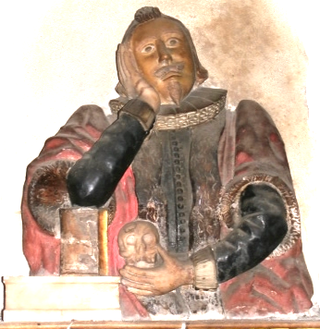
Thomas Horwood (1600-1658) of Barnstaple in Devon, was twice Mayor of Barnstaple, in 1640 and 1653. He founded an almshouse in Church Lane, Barnstaple. His mural monument survives in St Peter's Church, Barnstaple.

Rev. Martin Blake (1593-1673) was vicar of Barnstaple in Devon, 1628–56; 1660–73, and suffered much for his adherence to the Royalist cause during the English Civil War, as related in John Walker's Sufferings of the Clergy (1714). According to Chanter (1882), "The eventful history of the Rev. Martin Blake has been often written in public history and local annals".



















